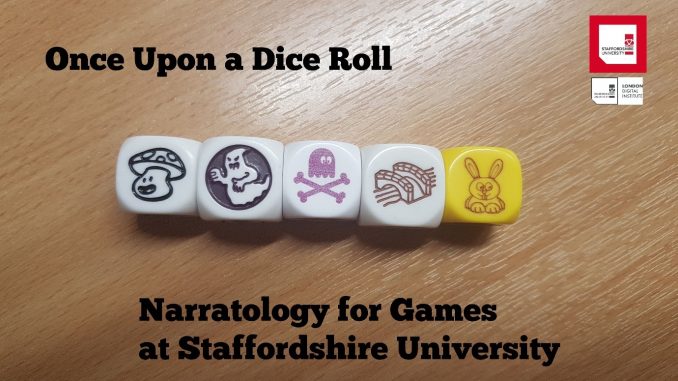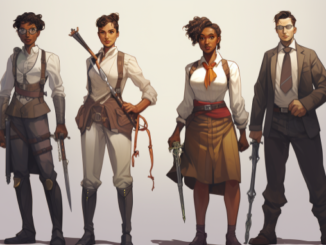
It all starts with dice ….
The first year Narratology for Games module has, as many long standing and ever-evolving programmes do, had an interesting history of being split, merged, moved around and eventually settled into its slot as a popular optional choice in the raft of first year choices. It’s also a work horse of a module combining analysis, friendship forging, narrative theory, academic writing and in recent years TWINE game construction. Our students come from a wide range of backgrounds, and prior experiences so there’s no suggestion of any pre-built in knowledge in any of the spheres the modules encompasses so we start from scratch, and in this modules case we start with dice.
Tabletop RPGs are cool now, they didn’t use to be (apart from on our campus which is the only university I know of where the roleplaying society is bigger then the rugby society) but the wealth of celebrity players that have emerged in recent years, hits like Critical Role and a general acceptance of, specifically, Dungeons and Dragons in popular culture means we have a lot of students who are eager to play a TRPG but haven’t met anyone else to play with, or who knows the ropes. While the lectures in the first semester look at introducing the history of narrative games, Interactive Fiction examples and experiments, live readings of Choose Your Own Adventure Books, Group play of Zork, narrative theory, game break downs etc the practical assignment in the first semester is simple. In your Groups (which in this case the system has arranged for you), pick a GM, pick a TRPG, plan, play and finish a campaign over a handful of weeks. Keep a play journal paying special attention to any world building that happens, characters arcs that emerge or narrative tropes that you identify.

The second part is a little trickier – analyse the play that happened and your role in it and tie it back to any of the narrative theory that we’ve covered in class. This does lead naturally to a lot of Freytag Pyramids and Heroes journey circle diagrams but it’s often the first time the students have considered in any great detail how narrative can be influenced by players, or how hard managing the expectations of players can be. Dipping their toes into auto-ethnographic analysis works well too to remind them they are starting on an academic path where we’ll encourage them to stop considering themselves just to be players of games – but designers and producers of them too.
Once Upon a Dice Roll
We hammer this home a little in the second semester with more applied narratology and the creation of TWINE (Klimas, 2009) narrative games – the students are given 12 weeks to design, produce, playtest and reflect on a game they’ve made. The complexity of the game is entirely up to them and much of the assessment focuses on their participation of documenting their games production and how they have interacted with the iterative design process laid out for them. The only constraint on the game is it must relate back to the random selection of story dice assigned to them – the dice rolls look like this.

These dice, pre rolled for convenience, are derived from the authors vast (and growing) collection of Story Cubes (O’Connor, 2004). The students are allowed to take them however they wish, and drop one if they want to, as long as they explain why they’ve dropped it in their production notes – but traces of the narrative aspects of these dice must be evident in the final version of the game submitted.
Alongside the creation of their own games, sometimes this is the first time the students have made a game solo, we also ask them to analyse the narrative of a game from the last 5 years – bringing that back to the narrative theory we introduced in the first semester, and expand on in the second. We also ask them to display much of this analysis in the form of flow diagrams – this again to help them consider how they communicate their ideas to teams so specific aspects aren’t lost in walls of texts. Hopefully, this is a skill they bring into play later on when they form part of collaborative groups into produce games and they need to communicate ideas to them.

This is How We Roll
As with so many long standing modules in university programmes we’ve had time to refine and see the effects of this module as the students progress through awards. Some TRPG groups thrown together by the computer in the first semester are still playing when they graduate 3 years later, and you can see the benefit of having a support network of likeminded individuals in place from the first week. Students come out of the module being able to call themselves ‘games designers’ for the first time – and often TWINE games turn up in Games Jams and projects going forward. Most of all this module with the analysis and the application of narrative and narrative theory dispels the idea that there is a role for the ‘ideas person’ who won’t need to understand engines, or code, or consider how their narrative effects the production of a game or the people that will play it.
References and further reading:
Klimas, C., 2009. TWINE. s.l.:Interactive Fiction Technology Foundation.
O’Connor, R., 2004. Rory’s Story Cube. s.l.:Asmodee.
- Once Upon a Dice Roll - 27th July 2020





This course sounds fantastic. I really wish I’d had the focus and had something like this available to me when I was choosing my degree. I love the group support focus, and the prompts/anchors way of using the dice is a great way to ground the project and give them a starting point. I’d imagine it also simulates working to a brief in a small way, while still leaving a lot of freedom for creativity.
Mapping the story in an existing game is a really good idea, too. Something I should do for myself, perhaps.